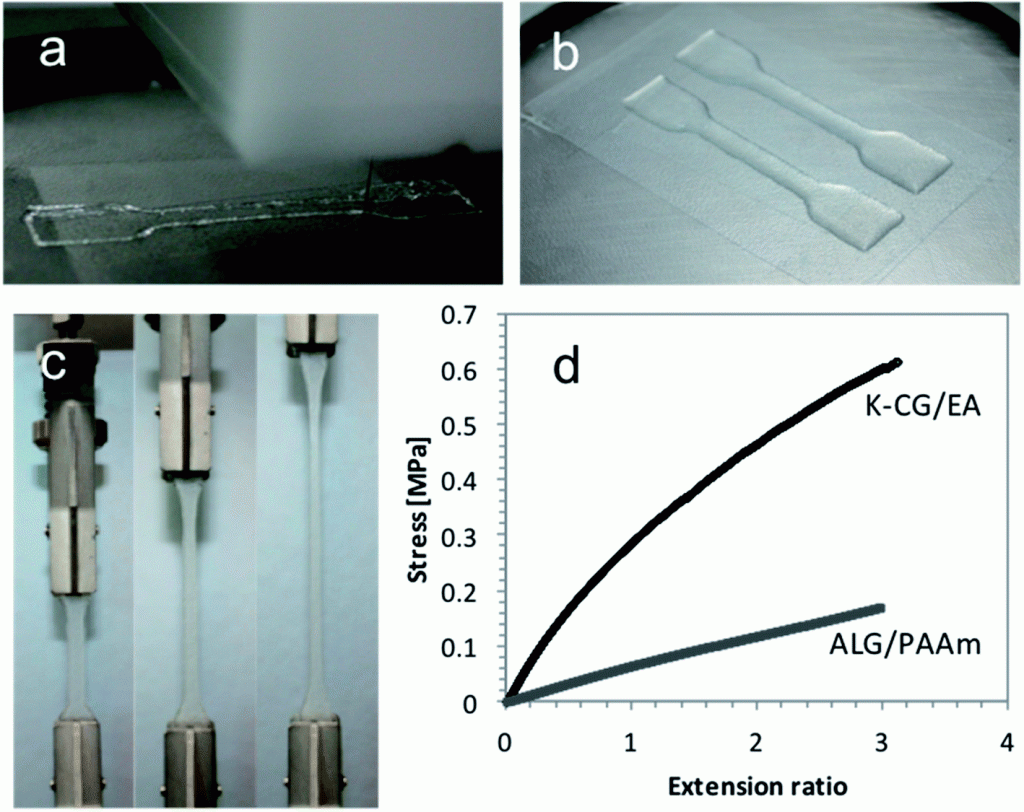When I was a kid, at least two highly educational hours a week were devoted to prime-time, riveted viewing of The Six Million Dollar Man and The Bionic Woman. These characters were part hero, part cyborg, put together with artificial parts, pure fiction and lots of magic—not to mention, outlandish fantasy.
No longer fiction or fantasy, scientists like Shannon Bakarich are working with the magical combination of science and 3D printing—outdoing themselves almost faster than news publications can print the headlines. Bakarich, a PhD candidate at the ARC Centre of Excellence for Electromaterials Science based at University of Wollongong in Australia, has come up with a new solution in 3D printing fiber-reinforced hydrogels.
Hydrogels are usually limited by their weak mechanical properties and challenging to work with in that they lack the strength of something like human cartilage; thus, scientists have been continually challenged in finding ways to make them tougher and more viable for use in tissue engineering.
Bakarich simultaneously prints with two inks on a 3D printer customized with a UV curing system. One ink cures into a soft and wet hydrogel and the other, to a hard and stiff plastic which forms the reinforcing fibers within the structure.
“Using computer-aided software, I can make a digital model of the fibers and hydrogel matrix, tuning the mechanical properties by carefully controlling the distribution of the fibers within our structures,” Shannon said.
Hydrogels are, quite simply, used as scaffolds for tissue engineering, which is the study of the growth of new connective tissues, or organs from cells. Tissue engineering is very important to the field of cartilage repair, as well as in the fields of bone repair and dermal wound healing, and has become a major field in its own right. It is all about understanding the principles of tissue growth, and applying this to produce functional replacement tissue for clinical use.
3D printing is in the beginning stages of revolutionizing medicine and Shannon’s new printing process is a good example. As the tools such as 3D printers and CAD software improve and research builds on itself, amazing things are happening. Powerful developments have been made by scientists in tissue engineering with 3D printing as of late, but they have been using a more limited two-step process. Bakarich’s new method gives greater control over the 3D distribution of the fibers, as well as being faster and simpler.
“The printed fibers give strength to the hydrogel in the same way fiberglass gives strength to a surfboard,” says Bakarich.
Just as 3D printing involves layer after layer of printed materials, progress in the medical field involves layer after layer of research, theory, and experimentation—with each solution improving on itself as more ideas and technology evolve to apply them. Shannon’s new technique takes this multidisciplinary field another step closer in implementing new progress.
The composite materials were fabricated by selectively pattering a combination of alginate/acrylamide gel precursor solution and an epoxy based UV-curable adhesive (Emax 904 Gel-SC) with an extrusion printer. UV irradiation was used to cure the two inks into a single composite material.
According to the research paper, spatial control of fiber distribution within the digital models allowed for the fabrication of a series of materials with a spectrum of swelling behavior and mechanical properties with physical characteristics ranging from soft and wet to hard and dry. A comparison with the “rule of mixtures” was used to show that the swollen composite materials adhere to standard composite theory.
Bakarich created a prototype of knee cartilage to llustrate the potential application in bioengineering, and offering great inspiration to other scientists in medical bionics– the application of biological methods and systems found in nature to the study and design of engineering systems and modern technology.
As baby boomers age, and the obesity epidemic continues, wear and tear on cartilage leads to tissue loss, exposing bony ends, causing deterioration and osteoarthritis—affecting 12.4 million senior citizens per year. These numbers are expected to increase, motivating scientists and doctors to find solutions. While they aren’t able to make people superhuman (yet!), they can seriously improve their quality of life.
The 3D printing technology, progressing in tandem with new breakthroughs in medicine propels doctors and scientists further along in creating many new vital applications in the tissue engineering field. What other recent, similar breakthroughs do you find interesting in the medical industry? Share your thoughts with us in the 3D printed hydrogel forum thread at 3DPB.com.
Subscribe to Our Email Newsletter
Stay up-to-date on all the latest news from the 3D printing industry and receive information and offers from third party vendors.
Print Services
Upload your 3D Models and get them printed quickly and efficiently.
You May Also Like
Comau’s Robotic Systems Take on 3D Printing Applications
Lately, Comau, the Italy-based manufacturer of robotic systems owned by One Equity Partners and automaker Stellantis, has formed a growing number of partnerships with companies in the additive manufacturing (AM)...
IC3D’s Next Chapter: Scaling Sustainability and Smarter Manufacturing in 2025
This article is part of a sponsored series highlighting America Makes’ member companies and their contribution to the additive manufacturing industry. 3DPrint.com is a proud member of America Makes. The...
ASTM International Launching New Manufacturer Certification Program for 3D Printing Industry
Eight years ago, standards organization ASTM International announced that it was looking for partners to help set up a center of excellence (CoE) in the additive manufacturing field. The resulting Additive Manufacturing...
University of Illinois Launches AM Research Center with $8M DoD Backing
The Department of Defense (DoD) has awarded $8.15 million to the University of Illinois Urbana-Champaign to support the establishment of an additive manufacturing (AM) research center at the Grainger College...



































